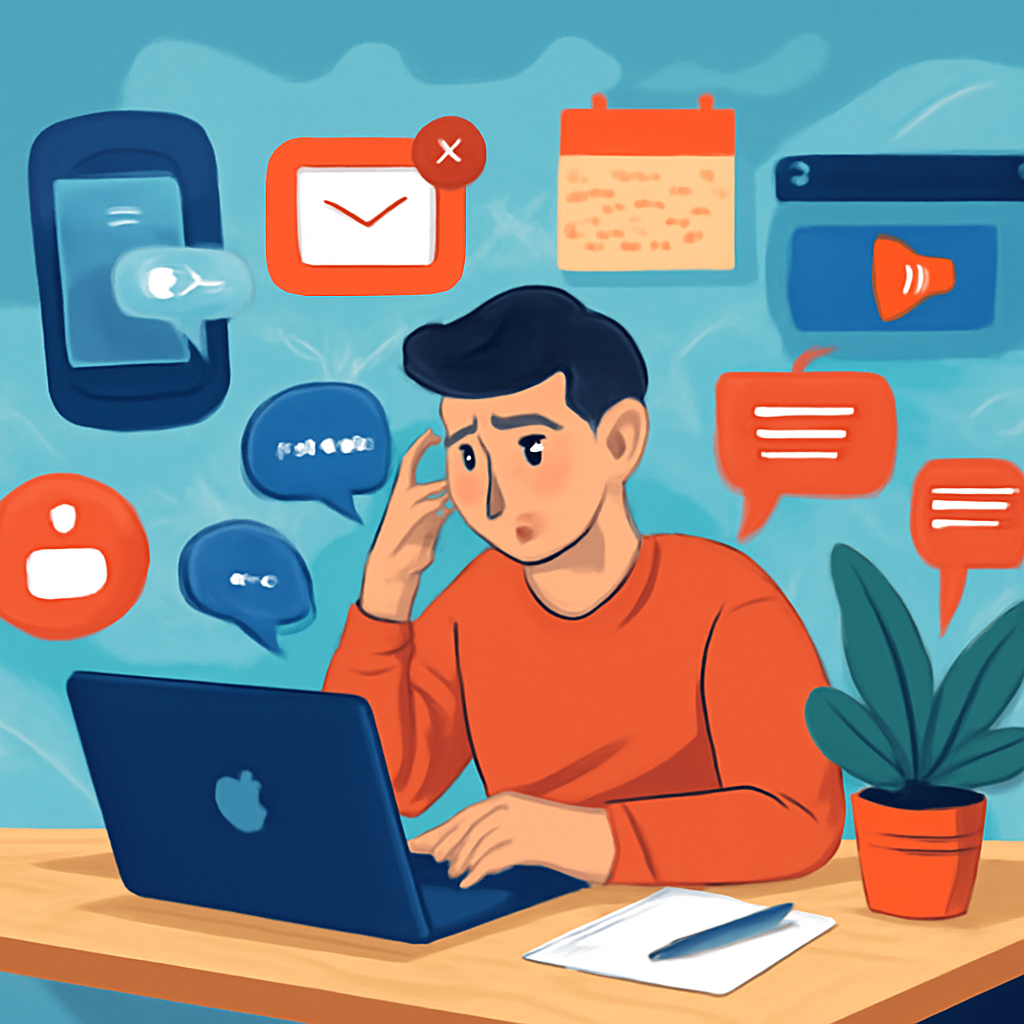Attention has become one of the most precious commodities. Every ping, buzz, or banner fights for your focus, making it difficult to maintain deep concentration. This article explores how to build focus in a fragmented digital world, providing practical, evidence-based strategies to regain control of your attention, enhance productivity, and improve mental well-being.

Struggling to focus amid constant digital distractions? You’re not alone. With attention spans shrinking and distractions multiplying, learning how to build focus in a fragmented digital world has never been more critical. This guide reveals practical tips and current trends to reclaim your attention and thrive in 2025’s hyperconnected environment.
Why Focus Is Harder Than Ever
The digital landscape today is characterized by fragmentation. Social media platforms, messaging apps, email, news alerts, streaming services, and countless other digital channels all compete for your attention at once. This cacophony is reshaping how we engage with information and work.
The Shrinking Attention Span
Research from Microsoft found that the average adult attention span dropped from 12 seconds in 2000 to just 8 seconds in 2015 — less than that of a goldfish (Microsoft 2015). This alarming trend highlights how digital bombardment is impairing our capacity to sustain focus on any one task.
The Hidden Costs of Digital Multitasking
Digital multitasking is a common response to fragmentation, but it comes with cognitive costs. Rubinstein, Meyer, and Evans (2001) found that switching tasks leads to a productivity loss of up to 40%, primarily due to the mental effort required to reorient after each switch.
When we attempt to juggle multiple digital streams—answering emails while scrolling social media or toggling between work and chat apps—our brains pay a hefty price. This constant switching not only slows us down but also increases mental fatigue and stress.
How to Build Focus in a Fragmented Digital World: Emerging Trends and Proven Techniques
Regaining focus in 2025 means more than just willpower; it requires adapting to new realities and using both behavioral strategies and technological tools effectively.
1. Harness Technology to Manage Distractions
While technology contributes to fragmentation, it also offers solutions designed to support focus.
- Focus Modes and Do Not Disturb Features: Modern smartphones and operating systems like iOS and Android include Focus modes that limit notifications based on your current activity. Setting up work-specific modes can reduce interruptions during important tasks.
- App and Website Blockers: Tools like Freedom, StayFocusd, and Forest help limit access to distracting websites or apps for set periods. Forest even gamifies focus by growing virtual trees during distraction-free time.
- AI-Driven Focus Assistants: Some emerging AI tools analyze your daily digital behavior to recommend optimal work and break times, balancing productivity with cognitive rest (Smith 2023).
Using these tools can reduce decision fatigue about when and how to limit distractions, making focused work more achievable.
2. Practice Mindfulness and Attention Training
Mindfulness practices have gained traction as effective methods to enhance attention control and reduce susceptibility to distractions.
- Mindfulness Meditation: Regular meditation strengthens the brain’s prefrontal cortex—the area responsible for attention regulation—and improves sustained focus (Zeidan et al. 2010). Even short daily sessions of 10 minutes can yield noticeable benefits.
- Pomodoro Technique: This popular time management strategy involves 25-minute focused work sessions followed by 5-minute breaks. It helps create rhythm and trains the mind to concentrate for manageable intervals.
- Digital Mindfulness Apps: Apps like Headspace and Calm provide guided meditation and breathing exercises designed to improve mental clarity and reduce digital stress.
By training your attention through these methods, you can better resist the urge to check your phone or multitask.
3. Optimize Your Physical and Digital Environment
A well-designed environment supports focus by minimizing external distractions and cognitive overload.
- Create a Distraction-Free Workspace: Choose a quiet place, declutter your desk, and use noise-canceling headphones if needed. Keeping your workspace tidy sends a signal to your brain that it’s time to concentrate.
- Simplify Your Digital Space: Limit the number of open tabs and running apps. Use minimalist desktop setups or tools like “focus mode” in browsers that hide unnecessary UI elements.
- Batch Tasks: Group similar tasks, such as answering all emails during a set time, to avoid constant task switching and repeated attention shifts.
- Reduce Visual Noise: Use grayscale modes or reduce color stimuli on devices to lower cognitive load and decrease temptation to browse distracting content.
Optimizing these surroundings can create a mental container that helps your brain stay anchored.
4. Schedule Regular “Digital Detox” Periods
Prolonged screen time can exhaust cognitive resources. Scheduling deliberate breaks from digital devices helps restore attention capacity.
- Daily Device-Free Intervals: Set periods each day without screen exposure—especially before sleep and immediately after waking. This practice improves sleep quality and reduces cognitive fatigue.
- Weekend or Vacation Breaks: Extended tech-free time can help recalibrate your brain’s attention system, reducing dependency on constant digital stimuli.
- Nature Exposure: Spending time outdoors, away from screens, has been shown to improve attention restoration and reduce mental fatigue (Berman et al. 2008).
These detoxes act as mental resets, allowing you to return to work refreshed and more focused.
5. Set Clear Intentions and Prioritize Effectively
Intentionality guides your focus and prevents aimless wandering through digital content.
- Daily Prioritization: Start your day by identifying your top 3 priorities. Use tools like to-do lists or digital planners to keep these goals visible.
- Time Blocking: Allocate specific blocks of time on your calendar for deep work, meetings, breaks, and personal time. Guard these blocks by informing colleagues or setting device boundaries.
- Limit Meeting Overload: Meetings often fragment the workday. Advocate for clear agendas, shorter meetings, or asynchronous communication when possible.
Setting these boundaries helps align your attention with meaningful work, reducing the pull of digital distractions.
Additional Strategies to Reinforce Focus
Leverage Accountability and Social Support
Sharing goals with peers or joining productivity groups can enhance motivation and reduce procrastination.
- Use coworking sessions or virtual focus groups (e.g., via Zoom) where participants work silently on tasks together and check in periodically.
- Accountability partners help keep you on track and reduce the temptation to drift into distractions.
Adopt Physical Wellness Habits
Physical health directly impacts cognitive performance.
- Regular Exercise: Physical activity improves blood flow to the brain, enhancing concentration and memory.
- Sleep Hygiene: Poor sleep impairs attention and increases distractibility. Aim for 7-9 hours of quality sleep.
- Healthy Nutrition: Balanced diets support brain function and energy levels throughout the day.
These habits create a foundation that makes focused work sustainable.
The Science Behind These Strategies
The effectiveness of these focus-building techniques is backed by solid research:
- Using focus modes and blockers reduces distractions and improves productivity by up to 30% (Kushlev and Dunn 2019).
- Mindfulness meditation enhances grey matter density in brain regions linked to executive attention (Hölzel et al. 2011).
- Time blocking and batching reduce cognitive switching costs and improve task completion rates (Mark, Gudith, and Klocke 2008).
- Regular digital detoxes promote attention restoration and reduce stress markers (Berman et al. 2008).
These findings emphasize that focus is a trainable skill and can be supported by smart habits and tools.
Looking Ahead: The Future of Focus in a Digital World
Emerging technologies promise to further support focus through personalized digital well-being.
- AI Personal Productivity Coaches: Advanced AI will soon offer real-time feedback on your attention patterns, suggesting when to switch tasks or take breaks.
- Brain-Computer Interfaces: Devices that monitor brain waves may soon adjust your digital environment dynamically to optimize focus states.
- Ambient Tech: Smart environments that adapt lighting, sound, and notifications based on your cognitive load are under development.
As these innovations mature, building focus will become a synergy of human habits and intelligent tech.
Conclusion
Learning how to build focus in a fragmented digital world is essential to maintaining productivity and mental health in 2025. By combining technological tools with mindfulness practices, environmental design, and intentional habits, you can regain control of your attention. Start by implementing small changes today, and over time, these strategies will help you sustain deep focus despite the digital noise.
References
- Microsoft (2015) ‘Attention spans’, Microsoft Attention Spans Research Report. Available at: https://www.microsoft.com/en-us/research/publication/attention-spans/ (Accessed: 3 June 2025).
- Rubinstein, J. S., Meyer, D. E., and Evans, J. E. (2001) ‘Executive control of cognitive processes in task switching’, Journal of Experimental Psychology: Human Perception and Performance, 27(4), pp. 763–797. https://doi.org/10.1037/0096-1523.27.4.763
- Smith, J. (2023) ‘AI-powered productivity tools are changing how we focus’, TechCrunch, 15 March. Available at: https://techcrunch.com/ai-productivity-focus/ (Accessed: 3 June 2025).
- Zeidan, F. et al. (2010) ‘Mindfulness meditation improves cognition: Evidence of brief mental training’, Consciousness and Cognition, 19(2), pp. 597–605. https://doi.org/10.1016/j.concog.2010.03.014
- Kushlev, K. and Dunn, E. W. (2019) ‘Checking email less frequently reduces stress’, Computers in Human Behavior, 100, pp. 165–173. https://doi.org/10.1016/j.chb.2019.06.005
- Hölzel, B. K. et al. (2011) ‘Mindfulness practice leads to increases in regional brain gray matter density’, Psychiatry Research: Neuroimaging, 191(1), pp. 36–43. https://doi.org/10.1016/j.pscychresns.2010.08.006
- Mark, G., Gudith, D., and Klocke, U. (2008) ‘The cost of interrupted work: More speed and stress’, Proceedings of the SIGCHI Conference on Human Factors in Computing Systems, pp. 107–110. https://doi.org/10.1145/1357054.1357072
- Berman, M. G. et al. (2008) ‘The cognitive benefits of interacting with nature’, Psychological Science, 19(12), pp. 1207–1212. https://doi.org/10.1111/j.1467-9280.2008.02225.x






